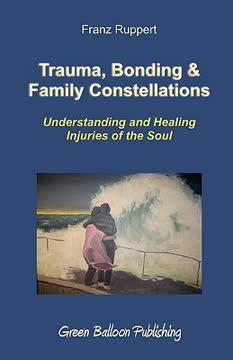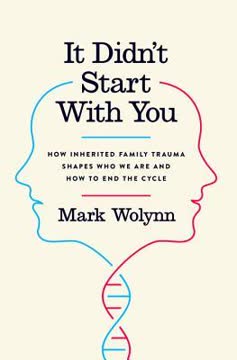Key Takeaways
1. Trauma and bonding disorders are intergenerational phenomena
Traumatic experiences are handed down to the next generation via the emotional bonding process.
Trauma transcends generations. Children absorb their parents' unresolved traumas through the emotional bonding process, often manifesting symptoms without directly experiencing the original traumatic events. This unconscious transmission can lead to psychological disorders, relationship difficulties, and a repetition of traumatic patterns across generations.
Bonding shapes personality. The quality of early attachment relationships, particularly with the mother, profoundly influences a child's emotional and psychological development. Secure attachments foster resilience and healthy relationships, while insecure or disorganized attachments can lead to various mental health issues and difficulties in forming stable relationships later in life.
Breaking the cycle requires awareness. Recognizing the intergenerational nature of trauma and bonding disorders is crucial for healing. By understanding how past events have shaped family dynamics, individuals can work to break destructive patterns and create healthier relationships for themselves and future generations.
2. Four types of trauma: existential, loss, bonding, and bonding system
The core emotional conflict stems from the fact that, despite the perceived danger of death, we cannot act and save our self through our own actions.
Existential trauma arises from life-threatening situations, such as accidents, violence, or natural disasters. It shatters one's sense of safety and control, often leading to anxiety disorders and PTSD.
Loss trauma results from the sudden or unexpected loss of a significant relationship or attachment figure. This can lead to depression, complicated grief, and difficulties in forming new attachments.
Bonding trauma occurs when primary caregivers are emotionally unavailable or abusive, disrupting the child's ability to form secure attachments. This can result in various personality disorders and relationship difficulties.
Bonding system trauma involves family secrets, crimes, or taboos that affect the entire family system. This type of trauma can lead to severe psychological disturbances, including psychosis and dissociative disorders.
3. Bonding trauma stems from emotionally unavailable parents
The key to understanding this process lies in the logic of the trauma. Traumatic experiences can lead to people being incapable of forming proper emotional attachments; they can form relationships as such, but not attachments.
Emotional unavailability perpetuates trauma. Parents who have experienced trauma often struggle to form secure attachments with their children, creating a cycle of bonding disorders. Their inability to process their own emotions leaves them ill-equipped to provide the emotional support and stability their children need.
Children absorb parental trauma. In seeking emotional connection, children may unconsciously take on their parents' unresolved traumas and suppressed emotions. This can lead to various psychological symptoms, including anxiety, depression, and identity issues, as the child struggles to differentiate their own emotions from those inherited from their parents.
Breaking the cycle requires healing. Recognizing and addressing parental trauma is crucial for breaking the intergenerational transmission of bonding disorders. Therapy that focuses on healing the parent-child relationship and helping parents process their own traumas can create the foundation for more secure attachments and healthier emotional development in children.
4. Bonding system trauma results from family secrets and crimes
Major crimes committed by human beings against each other cause the deepest psychological and traumatic wounds: crimes such as murder, manslaughter, robbery and rape.
Family secrets create psychological turmoil. When serious crimes or taboo acts occur within a family, the resulting secrecy and denial can have devastating effects on the entire family system. These hidden traumas can lead to severe psychological disturbances, including psychosis, dissociative disorders, and addictions.
Symptoms manifest across generations. The unresolved trauma and associated emotions often surface in later generations through seemingly unrelated symptoms or behaviors. Family members may experience inexplicable anxiety, depression, or compulsions that are actually manifestations of the hidden family trauma.
Healing requires truth and acknowledgment. Addressing bonding system trauma involves bringing hidden truths to light and acknowledging the impact of past events on the family system. This process can be painful but is essential for breaking the cycle of trauma transmission and allowing family members to heal and form healthier relationships.
5. Symptoms are protective mechanisms against traumatic memories
The symptom is seen as a necessary protective mechanism for overcoming a traumatic experience.
Symptoms serve a purpose. Rather than viewing psychological symptoms as problems to be eliminated, they should be understood as the psyche's attempt to protect itself from overwhelming traumatic memories. These protective mechanisms, while often distressing, have allowed the individual to survive and function despite their traumatic experiences.
Understanding symptom function is key. By recognizing the protective role of symptoms, therapists and clients can approach healing with greater compassion and insight. Instead of battling against symptoms, the focus shifts to understanding their underlying causes and finding healthier ways to process traumatic experiences.
Healing involves integration, not elimination. The goal of trauma therapy is not to eradicate symptoms, but to integrate traumatic experiences into one's life narrative. This process allows individuals to develop more adaptive coping strategies and reduce their reliance on symptoms as protective mechanisms.
6. Constellations method reveals hidden family dynamics
Constellations work and the phenomenon of representative perception challenges us to rethink our view of the world.
Accessing unconscious knowledge. The constellations method taps into a shared field of information, allowing representatives to accurately portray family dynamics and emotional entanglements without prior knowledge. This phenomenon challenges our understanding of how information is transmitted and stored within family systems.
Visualizing complex relationships. By physically representing family members and abstract concepts in space, constellations provide a tangible way to explore and understand complex relational dynamics. This visual and experiential approach can reveal hidden patterns and connections that may not be apparent through traditional talk therapy.
Facilitating emotional breakthroughs. The immersive nature of constellations work often leads to profound emotional insights and releases. Participants frequently report experiencing strong emotions or physical sensations that correspond to the family member they are representing, facilitating a deeper understanding of family dynamics and personal issues.
7. Healing involves reconnecting with split-off parts of personality
The split off traumatised part continues its existence within the personality structure as a whole.
Trauma causes fragmentation. Traumatic experiences can lead to the splitting off of certain aspects of personality as a protective mechanism. These dissociated parts contain the traumatic memories and associated emotions, allowing the individual to function in daily life.
Integration is key to healing. The therapeutic process involves helping clients reconnect with these split-off parts of themselves. This requires creating a safe environment where traumatic memories and emotions can be gradually accessed and processed without overwhelming the individual.
Constellations facilitate integration. The constellations method can be particularly effective in working with dissociated parts of personality. By physically representing different aspects of the self, clients can gain a clearer understanding of their internal dynamics and work towards integrating these split-off parts into a more cohesive whole.
8. Successful therapy leads to reconciliation with parents
Turning towards our parents and thereby towards our own deepest self is the end result of a successful therapy.
Healing the parent-child relationship. A crucial aspect of trauma therapy involves addressing and healing the relationship with one's parents. This process often involves acknowledging past hurts, understanding parental limitations, and finding a way to honor one's parents while maintaining healthy boundaries.
Self-acceptance through parental acceptance. By reconciling with one's parents, individuals often find greater self-acceptance and inner peace. This process allows for the integration of both positive and negative aspects of one's family heritage into a more complete sense of self.
Breaking intergenerational patterns. Reconciliation with parents can help break the cycle of intergenerational trauma transmission. By resolving conflicts and healing wounds from the past, individuals are better equipped to form healthier relationships with their own children and partners.
9. Sexual abuse requires careful, trauma-informed therapeutic approach
Diminishing the abuse ignores its ability to traumatise and fosters illusions about how easily its severe consequences may be overcome.
Acknowledging the severity. Sexual abuse is a particularly damaging form of trauma that requires a sensitive and informed therapeutic approach. Therapists must be prepared to address the complex emotional and psychological consequences of abuse without minimizing or overly dramatizing the experience.
Balancing disclosure and safety. While it's important to create a space where clients feel safe to disclose abuse, therapists should not pressure clients to reveal traumatic experiences before they are ready. The therapeutic process should respect the client's pace and boundaries while gently working towards uncovering and processing traumatic memories.
Addressing family dynamics. Sexual abuse often occurs within complex family systems, involving issues of loyalty, shame, and secrecy. Effective therapy must address these broader family dynamics while maintaining a clear stance on the perpetrator's responsibility for the abuse.
Last updated:
FAQ
1. What is Trauma, Bonding & Family Constellations by Franz Ruppert about?
- Explores psychological disorders: The book investigates the roots of psychological disorders, especially those with no clear external cause, such as depression, panic attacks, and psychosis.
- Focus on trauma and bonding: It emphasizes how trauma and disrupted emotional bonds, particularly in early childhood, are central to the development of these disorders.
- Multigenerational perspective: Ruppert introduces the idea that trauma and bonding issues are transmitted across generations, affecting entire family systems.
- Therapeutic methodology: The book presents family constellations as a systemic therapeutic approach to reveal and heal unconscious family and trauma dynamics.
2. Why should I read Trauma, Bonding & Family Constellations by Franz Ruppert?
- New perspective on mental health: The book challenges traditional psychiatric models, offering a trauma- and bonding-centered understanding of psychological suffering.
- Root cause focus: It encourages readers and therapists to look beyond symptoms and address the underlying causes of emotional pain.
- Practical therapeutic insights: The book provides a framework and methodology (family constellations) for working with complex trauma and bonding disorders.
- Personal and professional relevance: Both individuals seeking healing and professionals in mental health can benefit from its multigenerational and systemic insights.
3. What are the key takeaways from Trauma, Bonding & Family Constellations by Franz Ruppert?
- Trauma and bonding are central: Psychological disorders often stem from early bonding disruptions and unresolved trauma, not just individual pathology.
- Multigenerational transmission: Trauma is passed down through family systems, affecting descendants who may not be aware of the original events.
- Systemic healing is essential: Addressing the entire family system, not just the individual, is crucial for effective healing.
- Family constellations as a tool: The systemic constellations method is a powerful way to uncover and resolve hidden family dynamics and traumas.
4. What are the main concepts of bonding and trauma in Trauma, Bonding & Family Constellations by Franz Ruppert?
- Bonding as survival: Secure emotional bonds, especially with the mother, are foundational for psychological health and development.
- Trauma as soul injury: Trauma is defined as an overwhelming experience that fragments the psyche and disrupts emotional bonds.
- Types of trauma: Ruppert identifies existential trauma, loss trauma, bonding trauma, and bonding system trauma, each with unique emotional conflicts.
- Transmission through bonding: Traumatic experiences are passed down via emotional bonds, impacting future generations.
5. How does Franz Ruppert define psychological trauma in Trauma, Bonding & Family Constellations?
- Critical experience of helplessness: Trauma is the result of a situation where the threat exceeds an individual’s coping capacity, leading to feelings of helplessness.
- Subjective and situational: The traumatic impact depends on the person’s resources and the context, not just the event itself.
- Long-lasting effects: Trauma can cause dissociation, emotional numbing, and fragmented memory, deeply affecting perception and relationships.
- Biological and psychological response: Trauma triggers survival mechanisms like “freeze or fragment,” leading to lasting psychological symptoms.
6. What is Multigenerational Systemic Psychotraumatology (MSP) in Trauma, Bonding & Family Constellations?
- Integration of theories: MSP combines bonding theory, trauma theory, and family constellations methodology to understand and heal psychological disorders.
- Trauma transmission principle: Traumatic experiences are handed down through emotional bonds, affecting entire family systems.
- Multigenerational psyche: Psychological problems often originate from entanglements spanning three or more generations.
- Systemic healing required: Effective healing involves addressing the whole trauma-disturbed bonding network, not just the individual.
7. How does Trauma, Bonding & Family Constellations by Franz Ruppert explain the transmission of trauma across generations?
- Relational system impact: Trauma affects not just individuals but entire family and social systems, influencing those who did not directly experience the trauma.
- Emotional bonding as conduit: Trauma is transmitted through the emotional and psychological bonds between parents and children.
- Manifestation in descendants: Children and grandchildren may develop symptoms like anxiety or depression without conscious knowledge of the original trauma.
- Therapeutic implications: Recognizing and addressing multigenerational trauma is essential for effective therapy, often requiring systemic approaches.
8. What are bonding trauma and bonding system trauma in Franz Ruppert’s framework?
- Bonding trauma defined: Injuries in early emotional attachment, especially between mother and child, often due to neglect, abuse, or emotional unavailability.
- Bonding system trauma: Trauma that affects the entire family system, often involving severe events like incest, murder, or hidden family secrets.
- Multi-generational impact: Both types of trauma disrupt healthy development and are transmitted across generations, causing complex psychological issues.
- Need for systemic therapy: Healing these traumas requires approaches that address the whole family system, not just the individual.
9. How does the systemic constellations method work in Trauma, Bonding & Family Constellations by Franz Ruppert?
- Group-based process: Clients select representatives to embody family members or symptoms, revealing unconscious family dynamics.
- Representative perception: Representatives intuitively sense and express the emotional reality of those they represent, surfacing hidden traumas and secrets.
- Therapeutic application: The method helps clients visualize and process bonding and system traumas, facilitating emotional healing and reordering.
- Empirical and practical tool: Family constellations serve as both a therapeutic intervention and a way to refine theoretical understanding of trauma.
10. How does Trauma, Bonding & Family Constellations by Franz Ruppert link bonding trauma to personality disorders?
- Direct connection to disorders: Bonding trauma, especially involving neglect or abuse, is linked to disorders like Borderline, narcissistic, and antisocial personality disorders.
- Rejection of genetic explanations: Ruppert argues that these disorders are not primarily genetic but arise from early relational trauma and family dynamics.
- Transgenerational influence: Children of traumatized parents, especially mothers, may inherit emotional chaos and develop personality disorders.
- Therapeutic focus: Addressing family trauma is crucial for effective treatment of these complex disorders.
11. What role does sexual abuse play in family constellations and trauma in Trauma, Bonding & Family Constellations?
- Creates deep entanglements: Sexual abuse within families leads to emotional confusion, unhealthy loyalties, and secrecy.
- Affects mother-child bond: Mothers who have experienced sexual abuse may struggle with boundaries, impacting their ability to bond with their children.
- Societal denial: The book discusses how societal minimization of sexual abuse perpetuates family secrecy and trauma.
- Therapeutic necessity: Addressing sexual abuse openly in therapy is essential for breaking cycles of trauma and secrecy.
12. What are some key case studies and practical examples in Trauma, Bonding & Family Constellations by Franz Ruppert?
- Laura’s healing journey: A woman overcoming lifelong fear and trauma from sexual abuse and family secrets through constellations therapy.
- Martin’s family revelation: A man discovering hidden family trauma and finding emotional security by uncovering his father’s identity.
- Eva’s schizophrenia case: A client healing from schizophrenia by addressing her mother’s trauma linked to historical events, illustrating transgenerational effects.
- Demonstrates method’s impact: These cases show how systemic constellations can reveal and heal deep, multigenerational traumas.
Review Summary
Trauma, Bonding & Family Constellations receives mixed reviews, with an overall positive reception. Readers appreciate its insights into intergenerational trauma, attachment theory, and family dynamics. Many find it eye-opening and valuable for understanding personal experiences. Critics note the book's deterministic language and some questionable case studies. The translation quality in certain editions is criticized. Some readers find the content challenging but ultimately rewarding, while others struggle with its scientific validity. The book's approach to trauma and healing through family constellations generates both interest and skepticism.
Similar Books
Download PDF
Download EPUB
.epub digital book format is ideal for reading ebooks on phones, tablets, and e-readers.










